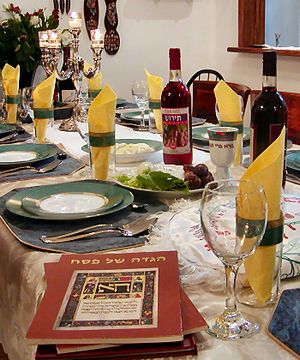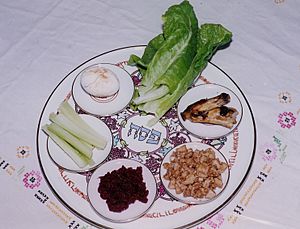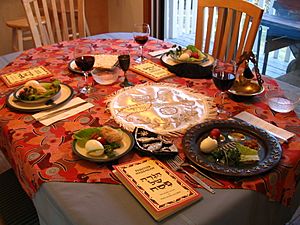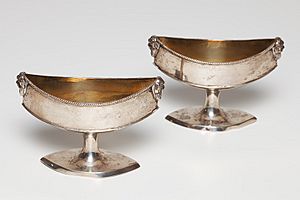Passover Seder facts for kids
Quick facts for kids Passover Seder |
|
|---|---|
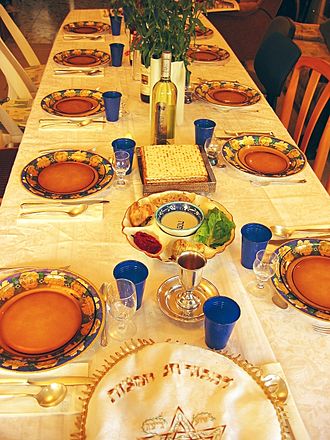
Table set for the Passover Seder
|
|
| Observed by | Jews, Samaritans, other groups claiming affiliation with Israelites |
| Type | Religious, cultural |
| Significance | To retell the story of the Exodus from Egypt |
| Celebrations | In Jewish practice, one or two festive Seder meals on the first two nights |
| Date | 15th day of Nisan |
| 2024 date | Evening, 23 April |
| 2025 date | Evening, 13 April |
| 2026 date | Evening, 2 April |
| 2027 date | Evening, 22 April |
| Related to | Three Pilgrimage Festivals (particularly Shavuot which follows 49 days from the second night of Passover) |
The Passover Seder is a special meal held at the start of the Jewish holiday of Passover. It happens on the evening of the 15th day of Nisan in the Hebrew calendar. This date usually falls in late March or April. Passover lasts for seven days in Israel and eight days outside Israel. Most Jewish families have one Seder if they are in Israel. If they are outside Israel, they usually have two Seders, one on each of the first two nights.
The Seder is a ritual meal where people retell the amazing story of the Israelites becoming free from slavery in ancient Egypt. This story comes from the Book of Exodus in the Jewish Torah. The Seder follows a Biblical command to remember this event. During the Seder, people read from a special book called the Haggadah. This book tells the story of the Exodus, includes special blessings, and has Passover songs.
Seder customs include telling and discussing the story, drinking four cups of wine, and eating matzah. People also eat symbolic foods and lean back to show they are free. The Seder is one of the most popular Jewish traditions, celebrated by Jews all over the world.
Contents
- What Happens at the Seder?
- Understanding Seder Themes
- The Seder Steps in Detail
- Kadeish: The First Cup
- Urchatz: Washing Hands
- Karpas: The Appetizer
- Yachatz: Breaking the Matzah
- Magid: Telling the Exodus Story
- Rohtzah: Second Hand Washing
- Motzi: Blessing Over Matzah
- Matzah: Eating Matzah
- Maror: Eating Bitter Herbs
- Korech: The Sandwich
- Shulchan Orech: The Meal
- Tzafun: Eating the Afikoman
- Bareich: Grace After Meals
- Hallel: Songs of Praise
- Nirtzah: Conclusion
- Different Kinds of Seders
- See also
What Happens at the Seder?
The Seder has 15 main steps, each with a special meaning. Here is a quick look at them:
- Kadeish (Bless!): Say a blessing and drink the first cup of wine.
- Urchatz (and Wash!): Wash hands without a blessing.
- Karpas (Vegetable): Dip a vegetable in salt water.
- Yachatz (Halving): Break the middle matzah. One piece is hidden for later.
- Maggid (Telling): Retell the Passover story. This includes asking "the four questions." Drink the second cup of wine.
- Rach'tzah (Washing): Wash hands again, this time with a blessing.
- Motzi ("Who brings out . . ."): Say a blessing over bread.
- Matzah (". . . matzah"): Say a blessing before eating matzah.
- Maror (Bitter): Eat bitter herbs.
- Koreich (Wraps): Eat a sandwich made of matzah and bitter herbs.
- Shulchan oreich (Set table): Enjoy the holiday meal.
- Tzafun (Hidden): Eat the hidden matzah piece (the afikoman).
- Bareich (Bless!): Say a blessing after the meal. Drink the third cup of wine.
- Hallel (Exalt!): Recite songs of praise. Drink the fourth cup of wine.
- Nirtzah (Desired): Say "Next Year in Jerusalem!"
The Seder usually takes place in a family home. Sometimes, synagogues or community centers host larger Seders for many people. It's common to invite guests, especially those who might not have a Seder to go to. The Seder is very important to Jewish identity. It reminds people that if God had not helped them, they would still be slaves in Egypt. Because of this, the Seder is a time to give thanks and celebrate freedom. It also helps pass down the Jewish faith from older generations to younger ones. Many Jews, even those who are not very religious, attend a Seder and eat matzah on Passover.
Family members dress in their best clothes for the Seder. The person leading the Seder might wear a white robe called a kittel. Everyone needs a plate and a wine glass. At the head of the table is a special Seder plate. This plate holds different symbolic foods. Nearby, there is a plate with three matzot and dishes of salt water for dipping.
Everyone gets a copy of the Haggadah. This old text contains the full Seder service. Both men and women can lead and take part in the Seder. Traditionally, people read the Haggadah in Hebrew and Aramaic. However, some parts must be said in a language everyone understands. So, important parts are often said in both Hebrew and the local language. The leader often stops to talk about the story with the children. They might also share ideas about what the words mean.
In some homes, people take turns reading parts of the Haggadah. This can be in Hebrew or in a translated language. It's a tradition for people to have pillows behind them to be comfortable. At certain times during the Seder, everyone leans to the left. This happens when drinking the four cups of wine, eating the Afikoman, and eating the korech sandwich. Leaning shows that they are free people.
Most Jews have one or two Seders. In Israel, there is one Seder on the first night of Passover. Outside Israel, many communities have a Seder on the second night too. Seders are celebrated all over the world, even in faraway places like the Himalaya mountains in Kathmandu, Nepal.
Understanding Seder Themes
Slavery and Freedom

The Seder's rituals and special foods remind everyone of two main ideas: slavery and freedom. The Haggadah says that "In every generation everyone is obligated to see themselves as if they themselves came out of Egypt." This means imagining you were a slave who became free.
In ancient times, a day began at sunset. The story of Exodus says that on the 15th of Nisan, the Jewish people were slaves to Pharaoh. After the tenth plague hit Egypt at midnight, Pharaoh let the Hebrew nation go. This made them free for the second half of the night.
So, during the Seder, people remember the slavery of the first half of the night. They eat matzah (called "poor person's bread"), maror (bitter herbs for the bitterness of slavery), and charoset (a sweet paste, like the mortar slaves used). To remember the freedom of the second half of the night, they eat matzah again (now the "bread of freedom") and the 'afikoman'. They also drink the four cups of wine while leaning back, and dip vegetables in salt water. Dipping is a sign of royalty and freedom.
The Four Cups of Wine
It is a special rule to drink four cups of wine during the Seder. Even poor people are supposed to drink them. Each cup is drunk at a specific part of the Seder. The first is for Kiddush (a blessing), the second for 'Maggid' (telling the story), the third for Birkat Hamazon (blessing after the meal), and the fourth for Hallel (songs of praise).
The Four Cups stand for four promises God made to free the Israelites: "I will bring out," "I will deliver," "I will redeem," and "I will take."
Some Jewish thinkers connect the Four Cups to four different worlds or stages of history. Others link them to the four mothers of the Jewish people: Sarah, Rebeccah, Rachel, and Leah. The three matzot on the table are linked to the three fathers: Abraham, Isaac, and Jacob. One idea is that the four cups are like the Roman custom of drinking a cup for each letter in the name of the main guest. At the Seder, the main guest is God, whose Hebrew name has four letters.
The Seder Plate
The special Passover Seder plate (ke'arah) holds symbolic foods. Each of the six items on the plate helps tell the story of the Exodus from Egypt. A seventh item, a stack of three matzot, is placed on its own plate.
The six items on the Seder plate are:
- Maror: Bitter herbs, like horseradish. These remind us of the harsh slavery the Jews faced in Egypt.
- Chazeret: Often romaine lettuce, which also has a bitter taste. Other bitter greens can be used.
- Charoset: A sweet, brown paste made of fruits and nuts. It might represent the mortar the slaves used to build with. Recipes vary by family tradition.
- Karpas: A vegetable like parsley or potato. It is dipped in salt water (for tears), vinegar, or charoset.
- Zeroa: A roasted lamb or goat bone. This symbolizes the lamb sacrifice offered in the Temple in Jerusalem long ago.
- Beitzah: A roasted hard-boiled egg. This symbolizes another festival sacrifice offered in the Temple.
Focusing on Children
The main goal of the Seder is to tell the Exodus story to children. So, a lot of effort goes into making it interesting for them and keeping them awake! Asking and answering questions is a big part of the Seder. When children ask questions, they are more ready to hear the answers.
The most famous question is the "Ma Nishtana" – 'Why is this night different from all other nights?' The youngest child usually asks this. After the questions, the main part of the Seder, Magid, explains the answers by reviewing the history. Also, the Seder leader might cover the matzot or lift their wine cup. These actions are meant to make children curious and ask questions.
Some families act out parts of the Exodus story during the Seder. Families might also ask their own questions and give small prizes, like nuts or candy, for correct answers. The afikoman is another way to get kids involved. This piece of matzah is hidden, and the children have to find it. The child who finds it usually gets a prize. In some homes, the children hide it, and the parents have to find it. Then the children ask for a reward!
The Seder Steps in Detail
The order of the Seder is written in the Passover Haggadah. Jewish children often learn the names of the steps with a rhyme:
Kadeish: The First Cup
Kadeish means "bless" in Hebrew. This blessing is said after synagogue services, but only after nightfall. It is similar to blessings said on other Jewish holidays, but it also mentions matzot and the Exodus. Many Jews fill each other's cups at the Seder table to show freedom and importance. The father of the house usually says the blessing, but everyone can join in. Everyone should drink most of the first cup of wine.
Urchatz: Washing Hands
According to Jewish law, you should wash your hands if you eat fruits or vegetables that are wet and dipped in liquid. At this point in the Seder, most traditions do not say a blessing when washing hands. However, some traditions do say a blessing.
Karpas: The Appetizer
Each person dips a vegetable into something. Ashkenazi Jews usually use salt water, which reminds them of the tears their enslaved ancestors cried. Sephardi Jews often use vinegar. Some older Sephardi customs, still common among Yemenite Jews, use charoset.
Yachatz: Breaking the Matzah
Three matzot are stacked on the Seder table. At this step, the middle matzah is broken in half. The larger piece is hidden. This hidden piece is called the afikoman and will be eaten later as the "dessert." The smaller piece stays between the other two matzot.
Moroccan Jews have a custom to sing a song about God splitting the Red Sea when the matzah is broken. Before the Magid section, some Sephardi families sing "Bivhilu yatzanu mi-mitzrayim" (meaning "In haste we left Egypt"). While singing, the head of the house waves the Seder plate over everyone's head.
Magid: Telling the Exodus Story
This is where the story of Passover is told. It explains how the Jewish people went from slavery to freedom. Moroccan Jews often raise the Seder plate over everyone's heads while chanting a phrase about leaving Egypt in haste.
Ha Lachma Anya: The Invitation
The matzot are uncovered and called the "bread of affliction." Everyone says an invitation in Aramaic for anyone who is hungry or needy to join the Seder. This invitation must also be said in the local language.
Mah Nishtanah: The Four Questions
The Mishna says that certain questions must be asked on Seder night. The youngest child usually asks the "Four Questions." Some families have everyone say them quietly. If there are no children old enough to ask, an adult, like a spouse, can ask. Even if someone is alone, they must ask and answer the questions themselves.
Ma nishtana ha lyla ha zeh mikkol hallaylot?
Why is this night different from all other nights?
- Why is it that on all other nights we eat either regular bread or matzah, but on this night we eat only matzah?
- Why is it that on all other nights we eat all kinds of vegetables, but on this night we eat bitter herbs?
- Why is it that on all other nights we do not dip our food even once, but on this night we dip them twice?
- Why is it that on all other nights we eat either sitting up or leaning, but on this night we all lean?
The answers to these questions are:
- We eat only matzah because our ancestors had to leave Egypt so quickly that their bread didn't have time to rise.
- We eat bitter herbs to remember the bitter and hard times our ancestors faced as slaves in Egypt.
- We dip twice: first, green vegetables in salt water to remember tears turning to thanks. Second, bitter herbs in charoset to sweeten the bitterness of suffering.
- We lean at the Seder table because in ancient times, only free people could lean while eating. Slaves and servants had to stand.
The Four Questions have been translated into over 300 languages!
The Four Children
The Haggadah talks about "four children": one who is wise, one who is wicked, one who is simple, and one who doesn't know how to ask. Each child asks about the Seder in a different way. The Haggadah suggests answering each child based on their question.
The wise child asks very detailed questions about the laws of Passover. They want to know how to do the Seder correctly. They are given a full answer.
The wicked child asks, "What is this service to you?" The Haggadah says this child acts like they are separate from the Jewish people. They are watching, not participating. So, the answer reminds them that God acted for my sake when I left Egypt, implying the Seder is not for those who don't feel part of the community.
The simple child asks, "What is this?" They are told, "With a strong hand God led us out from Egypt, from the house of slavery."
And the child who doesn't know to ask is simply told, "It is because of what God did for me when I left Egypt."
Some modern Haggadahs use "children" instead of "sons." Some even add a fifth child. This fifth child can represent children who did not survive the Shoah to ask questions. Or, it can represent Jews who have moved away from Jewish life and don't take part in a Seder.
"Go and Learn"
The Seder then explains four verses from the Deuteronomy (26:5–8) in detail. These verses describe the Jewish people's slavery and how God saved them. This part includes listing the Ten Plagues God sent upon Egypt:
- Dam (blood) – All water turned to blood.
- Tzefardeyah (frogs) – Frogs covered Egypt.
- Kinim (lice) – Egyptians were covered in lice.
- Arov (wild animals) – Wild animals (or flies) swarmed Egypt.
- Dever (pestilence) – A plague killed Egyptian animals.
- Sh'chin (boils) – Boils appeared on Egyptians.
- Barad (hail) – Hail rained down.
- Arbeh (locusts) – Locusts swarmed over Egypt.
- Choshech (darkness) – Egypt was covered in darkness.
- Makkat Bechorot (killing of the first-born) – All first-born Egyptian sons were killed.
When the plagues are named, each person removes a drop of wine from their cup. This shows that even though it's a joyful night, we can't be completely happy when others suffered. A short phrase, "D'tzach Adash B'achav," is used to remember the plagues, and a drop of wine is spilled for each word.
After this, songs of praise are sung, like Dayenu. This song says that if God had done only one of the many things for the Jewish people, it would have been enough to be thankful. Then, the reasons for eating the Paschal lamb, Matzah, and Maror are explained. A long blessing is said, and the second cup of wine is drunk.
Rohtzah: Second Hand Washing
The ritual hand-washing is done again. This time, a blessing is said.
Motzi: Blessing Over Matzah
Two blessings are said. First, the usual blessing before eating bread.
Matzah: Eating Matzah
Then, a blessing for the commandment to eat Matzah is said. An olive-sized piece of matzah is eaten while leaning to the left.
Maror: Eating Bitter Herbs
A blessing for eating the maror (bitter herbs) is said, and then it is eaten.
Korech: The Sandwich
The maror is placed between two small pieces of matzah, like a sandwich. This follows the tradition of Hillel, a wise teacher from 2000 years ago.
Shulchan Orech: The Meal
The festive meal is eaten! It often starts with a hard-boiled egg dipped in salt water. There's a Yiddish saying: "We set the table and eat the fish."
Tzafun: Eating the Afikoman
The afikoman, which was hidden earlier, is the last food eaten at the Seder. Each person gets a small piece of matzah for the afikoman. After eating it, no other food can be eaten for the rest of the night. Only the last two cups of wine can be drunk.
Bareich: Grace After Meals
The Birkat Hamazon (Grace after Meals) is recited.
Kos Shlishi: The Third Cup
The third cup of wine is drunk. This cup is usually poured before the Grace after Meals. It is also a "Cup of Blessing" for special occasions.
In many traditions, the front door is opened at this point. Special verses from the Psalms are recited.
Most Ashkenazi Jews fill a fifth cup at this point. This cup is for Elijah, a prophet who is believed to visit every home on Seder night. It hints at his future arrival to announce the coming of the Jewish Messiah.
Some Seders also set out a cup for the prophet Miriam, along with Elijah's cup. This honors Miriam. Miriam's cup started in the 1980s and is linked to the story of Miriam's well. This well miraculously followed the Israelites in the desert. Also, some Jews put an orange on the Seder plate. The orange stands for including all marginalized people, especially women and gay people, in the Jewish community.
Hallel: Songs of Praise
The full Hallel (songs of praise) that are usually said in synagogue on holidays are also said at the Seder table, but while sitting. The first two psalms (113 and 114) were said before the meal. The rest (115–118) are said now. Psalm 136 (the Great Hallel) is also said, followed by Nishmat, a prayer from the morning service.
After this, the fourth cup of wine is drunk, and a short blessing for wine is said.
Nirtzah: Conclusion
The Seder ends with a prayer asking that the night's service be accepted. A hope for the Messiah is expressed: "L'shanah haba'ah b'Yerushalayim! – Next year in Jerusalem!" Jews in Israel, especially in Jerusalem, say "L'shanah haba'ah b'Yerushalayim hab'nuyah! – Next year in the rebuilt Jerusalem!" Jerusalem is a holy city and a symbol of spiritual perfection. Saying "Next year in Jerusalem" means we hope for a perfect world soon.
Even though the 15 Seder steps are done, the Haggadah has more songs. These songs tell more about the miracles in Ancient Egypt and throughout history. Some songs pray for the Beit Hamikdash to be rebuilt soon. The last song is Chad Gadya ("One Kid Goat"). This song, which seems like a children's rhyme, is actually a story about God's justice against the enemies of the Jewish people.
After the Seder, those who are still awake might read the Song of Songs, study Torah, or keep talking about the Exodus story until they fall asleep.
Different Kinds of Seders
Feminist Seders
In 1976, the first women-only Passover Seders began in New York City. Women created a "Women's Haggadah" to include women where only men had been mentioned in traditional Haggadahs. This Haggadah features wise women, four daughters, women's questions, and women-focused plagues. These Seders are still held today. As mentioned, some Seders now include a cup for Miriam and an orange on the Seder plate to symbolize inclusion for all marginalized people. Many Haggadahs now also use gender-neutral English words.
Public Seders
A group of people holding a Passover Seder together is called a chavurah (group). In places like the Far East, Jewish leaders often hold Seders for hundreds of students and travelers. The Chabad Seder in Kathmandu often has over 1,200 people! In 2006, over 500 public Seders were held in the Former Soviet Union, with more than 150,000 people attending.
In Israel, where people usually have only one Seder, students from other countries are often invited to "second-day Seders" hosted by organizations and families.
Christian Seders
Some Christians, especially Evangelical Protestants, have become interested in holding Seders. Many churches host Seders, often adding a Christian message. They sometimes invite Messianic Jews to lead and teach. The Gospels say the Last Supper happened during Passover, so some Christians see it as a Seder. Because of this, some Christian Seders are held on Maundy Thursday to remember the Last Supper. Many Christians feel this helps them connect with their religion's history. However, the Seder as we know it today developed after Christianity and Judaism became separate religions. Some Jews and Christians believe Christian Seders are not appropriate, as they use Jewish rituals for non-Jewish reasons.
Interfaith Seders
Many churches hold interfaith Seders. Here, Jews and non-Jews share the story and discuss ideas like peace, freedom, and religious tolerance. During the American civil rights movement in the 1960s, interfaith Seders helped inspire leaders from different communities to work for equal rights. The first "Freedom Seder" was held in 1969. It celebrated the freedom struggle of Black Americans alongside that of ancient Israel. This led to many Haggadahs celebrating other forms of liberation, like feminism and environmental healing. Today, many Unitarian Universalist churches hold yearly interfaith Seders.
White House Passover Seder
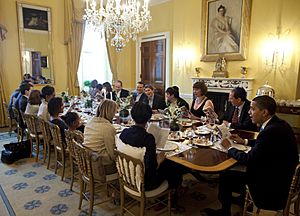
In 2009, President Barack Obama started holding an annual Passover Seder at the White House. This was the first time a US president hosted a Seder there. It was a private dinner for about 20 guests, both Jewish and non-Jewish. It included reading the Haggadah, traditional rituals like hiding the afikoman and Elijah's cup, and reading the Emancipation Proclamation.
Virtual Seders
When people can't be together physically for a Seder, they can use technology like videoconferencing to have a "virtual" Seder. In 2020, the COVID-19 pandemic caused many virtual Seders to happen. People wanted to practice social distancing or were required to stay home. Websites that help organize Seders saw a big increase in virtual Seders. Zoom was widely used for them. Some rabbis supported virtual Seders, while others did not, due to rules about using electronics on holidays.
Seder in Space
In 2022, Israeli astronaut Eytan Stibbe held the first Seder in space! He was on the International Space Station. On the first night of Passover, he recited kiddush, drank grape juice, and ate matzah. He told his fellow astronauts about the values of the Seder tradition. He said the story of the Exodus, "from slavery into freedom," shows that "no dream is beyond reach."
See also
 In Spanish: Séder de Pésaj para niños
In Spanish: Séder de Pésaj para niños



